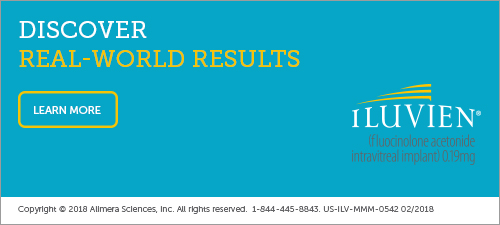
Volume 14, Number 4 |
April 2018 |

WELCOME to Review
of Ophthalmology's Retina Online newsletter. Each month, Medical Editor Philip Rosenfeld, MD, PhD, and our editors provide you with this timely and easily accessible report to keep you up to date on important information affecting the care of patients with vitreoretinal disease.
|

|
Impact of Intravitreal Aflibercept on DR Progression in VIVID-DME & VISTA-DME
Researchers evaluated the impact of intravitreal aflibercept (Eylea, Regeneron Pharmaceuticals) vs. laser on progression of diabetic retinopathy severity in the Regeneron-sponsored VIVID-DME and VISTA-DME studies, as part of secondary and exploratory analyses of the phase III, randomized, controlled studies. Participants included all individuals with a baseline Diabetic Retinopathy Severity Scale score based on fundus photograph (full analysis), individuals who progressed to proliferative DR (safety analysis) in VIVID-DME (n=403) and VISTA-DME (n=459), or both.
Researchers randomized individuals with diabetic macular edema to intravitreal aflibercept 2 mg every four weeks, intravitreal aflibercept 2 mg every eight weeks after five initial monthly doses, or macular laser photocoagulation at baseline and sham injections at every visit. Main outcome measures included proportions of individuals with two- and three-step or more improvements from baseline in DRSS score, who progressed to PDR and who underwent panretinal photocoagulation.
Among individuals with an assessable baseline DRSS score, most showed moderately severe or severe nonproliferative DR.
The proportions of treated individuals at week 100 with a two-step or more improvement in DRSS score in VIVID-DME were:
• 2q4: 29.3 percent;
• 2q8: 32.6 percent; and
• laser: 8.2 percent.
The proportions of treated individuals at week 100 with a three-step or more improvement in DRSS score in VISTA-DME were:
• 2q4: 37 percent;
• 2q8: 37.1 percent; and
• laser: 15.6 percent.
The proportions with a three-step or more improvement in the DRSS score in VIVID-DME were:
• 2q4: 7.3 percent;
• 2q8: 2.3 percent; and
• laser: 0 percent.
The proportions with a three-step or more improvement in the DRSS score in VISTA-DME were:
• 2q4: 22.7 percent;
• 2q8: 19.9 percent; and
• laser: 5.2 percent.
Fewer individuals in the 2q4 and 2q8 groups vs. the laser group progressed to PDR at week 100 in VISTA-DME (2q4: 1.5 percent and 2q8: 2.2 percent vs. laser: 5.3 percent) and VIVID-DME (2q4: 3.2 percent and 2q8: 2 percent vs. laser: 12.3 percent). The proportions of individuals who underwent PRP were:
(in VIVID-DME):
• 2q4: 2.9 percent;
• 2q8: 0.7 percent; and
• laser: 4.5 percent; and
(in VISTA-DME):
• 2q4: 1.9 percent;
• 2q8: 0.7 percent; and
• laser: 5.2 percent.
The most frequent serious ocular adverse event at week 100 was cataracts: pooled intravitreal aflibercept, 1.7 percent; laser, 3.5 percent.
Researchers wrote that their findings demonstrated the benefit of intravitreal aflibercept over laser with respect to DR progression, and suggested a benefit for DME and underlying DR.
SOURCE: Mitchell P, McAllister I, Larsen M, et al. Evaluating the impact of intravitreal aflibercept on diabetic retinopathy progression in the VIVID-DME and VISTA-DME studies. Ophthalmology Retina 2018; Mar 31. [Epub ahead of print].
ANGPTL3 as a Potential Biomarker for Retinopathy in Type 2 Diabetes
Scientists analyzed whether angiopoietin-like 3 and angiopoietin-like 4 were differentially associated with the severity of retinopathy in individuals with type 2 diabetes mellitus, as part of a cross-sectional study.
Scientists quantified serum levels of ANGPTL3, ANGPTL4, high-sensitivity C-reactive protein, vascular adhesion molecule-1, intracellular adhesion molecule-1 and vascular endothelial growth factor. They recorded retinal images to assess the grade of diabetic retinopathy and performed multivariable-adjusted logistic analysis to estimate the association of each biomarker and DR stage.
Among 1,192 T2DM individuals, 426 (35.7 percent) had nonproliferative diabetic retinopathy and 56 (4.5 percent) had proliferative diabetic retinopathy. After adjusting for covariables, the odds ratios were as follows:
risk of having DR vs. no DR (n=710 vs. 482):
• 1.23 (CI, 1.08 to 1.40, p=0.002) for ANGPTL3;
• 0.90 (CI, 0.79 to 1.02; p=0.095) for ANGPTL4; and
• 1.14 (CI, 1 to 1.29; p=0.044) for VEGF;
risk of having no DR vs. NPDR (n=710 vs. 426):
• 1.16 (CI, 1.01 to 1.32; p=0.036) for ANGPTL3;
• 0.90 (CI, 0.79 to 1.04; p=0.15) for ANGPTL4; and
• 1.14 (CI, 1 to 1.31; p=0.045) for VEGF; and
risk of having NPDR vs. PDR (n=426 vs. 56):
• 1.47 (CI, 1.03 to 2.10; p=0.035) for serum ANGPTL3;
• 0.96 (CI, 0.69 to 1.35; p=0.83) for ANGPTL4; and
• 1.05 (CI, 0.77 to 1.45; p=0.74) for VEGF.
Scientists concluded that ANGPTL3 was independently and strongly associated with DR progression in all stages. They suggested that blockade of the ANGPTL3 signal in the retina might postpone the onset and development of DR in with individuals type 2 diabetes mellitus.
SOURCE: Yu CG, Yuan SS, Yang LY, et al. Angiopoietin-like 3 is a potential biomarker for retinopathy in type 2 diabetic patients. Am J Ophthalmol 2018; April 2. [Epub ahead of print].
Loss to Follow-up in PDR Cases
Researchers wrote that loss to follow-up may contribute to vision loss in individuals with active proliferative diabetic retinopathy. They aimed to determine and compare the rates of LTFU in individuals with PDR receiving panretinal photocoagulation or intravitreal injections with anti-vascular endothelial growth factor over approximately four years. They also assessed various risk factors for LTFU.
The retrospective cohort study included a total of 2,302 individuals with PDR receiving IVIs with anti-VEGF or PRP between January 1, 2012, and April 20, 2016.
Researchers measured intervals between each procedure and the subsequent follow-up visit. They defined loss to follow-up as at least one interval exceeding 12 months duration. Main outcome measures included LTFU rates and associated risk factors.
• A total of 1,718 individuals (74.6 percent) followed up post-procedure and 584 individuals (25.4 percent) were LTFU over approximately four years.
• Of those receiving PRP, 28 percent were LTFU compared with 22.1 percent of individuals receiving IVI with anti-VEGF (p=0.001).
• LTFU rates decreased as age increased, with rates of 28.1 percent for individuals ages ≤55 years, 27 percent for individuals ages 56 to 65 years, and 20.9 percent for individuals ages >65 years (p=0.002).
• Loss to follow-up also differed by race, with rates of: 19.4 percent for whites; 30.2 percent for African Americans; 19.7 percent for Asians; 38 percent for Hispanics, Native Americans and Pacific Islanders; and 34.9 percent for individuals of unreported race (p<0.001).
• LTFU rates also increased as regional average adjusted gross incomes decreased, with rates of 33.9 percent for individuals with regional average AGI of ≤$40 000, 24 percent for individuals with regional average AGI from $41,000 to $80,000, and 19.7 percent for those with regional average AGI >$80,000 (p<0.001).
• Procedure type, age, race and regional average AGI were all significant (p<0.05) independent risk factors of LTFU in the multivariate regression.
Researchers wrote that a large proportion of individuals with PDR were LTFU after receiving PRP or an anti-VEGF injection over approximately four years. They added that key risk factors included age, race and regional average AGI.
SOURCE: Obeid A, Gao X, Ali FS, et al. Loss to follow-up in patients with proliferative diabetic retinopathy after panretinal photocoagulation or intravitreal anti-vegf injections. Ophthalmology 2018; Mar 29. [Epub ehead of print].
Risk Factors for Filtration Surgery Need After Vitrectomy in PDR
Scientists retrospectively reviewed individuals with postoperative neovascular glaucoma after vitrectomies for proliferative diabetic retinopathy to investigate how variables assessed before, during and after vitrectomy were associated with the subsequent need for filtration surgery.
The subjects in this retrospective, observational, comparative study were 55 consecutive individuals (61 eyes) who underwent vitrectomy for PDR at Toho University Sakura Medical Center between December 2011 and November 2016, who were followed for at least six months after surgery, and who developed NVG within two years after surgery. The group included 44 men and 11 women of mean age 52.4 ±9.1 years, followed up for a mean 7.1 ±6.1 months. Scientists collected data on the following 16 variables: sex, age, history of panretinal photocoagulation completed within three months before vitrectomy, presence/absence of a lens, obvious iris/angle neovascularization, tractional retinal detachment, diabetic macular edema, vitreous hemorrhage, visual acuity, intraocular pressure before vitrectomy and at the onset of NVG, glycated hemoglobin, fasting blood glucose, estimated glomerular filtration rate and use of intraoperative gas tamponade.
Logistic regression analysis with the backward elimination method identified preoperative fasting hyperglycemia (p=0.08), high intraocular pressure at the onset of NVG (p=0.04) and use of gas tamponade during vitrectomy (p=0.008) to be significant risk factors for requirement of filtration surgery.
Scientists determined that preoperative fasting hyperglycemia, high intraocular pressure at the onset of NVG and use of gas tamponade during vitrectomy predisposed individuals to require filtration surgery in the event of postoperative NVG.
SOURCE: Sakamoto M, Hashimoto R, Yoshida I, et al. Risk factors for requirement of filtration surgery after vitrectomy in patients with proliferative diabetic retinopathy. Clin Ophthalmol 2018;12:733-8.

Aflibercept vs. Ranibizumab Frequency in Treat-and-extend Regimen for CRVO
Researchers prospectively investigated the injection frequency of aflibercept and ranibizumab in the treatment of macular edema in central retinal vein occlusion.
Individuals with treatment-naive CRVO and ME were randomized to receive intravitreal injections with aflibercept (n=22) or ranibizumab (n=23) in a treat-and-extend regimen, with a follow-up time of 18 months. After three loading doses, the treatment intervals were extended by two weeks to a maximum of 12 weeks. Intervals were shortened by two weeks if macular edema recurred.
The number of injections was significantly lower in the aflibercept group, with a mean of 10.9 injections (CI, 9.6 to 12.3) compared with 14.4 in the ranibizumab group (CI, 12.7 to 16.1) at study completion (p=0.0017). The mean treatment interval was significantly longer in the aflibercept group compared with the ranibizumab group at 10 (CI, 8.7 to 11.3) and 6.6 (CI, 5.2 to 8) weeks, respectively (p<0.001). Researchers found no significant difference between the groups regarding visual acuity or central retinal thickness.
Researchers determined that individuals with ME secondary to CRVO required significantly fewer intravitreal injections of aflibercept compared with ranibizumab when treated with a treat-and-extend regimen.
SOURCE: Casselholm de Salles M, Amrén U, Kvanta A, et al. Injection frequency of aflibercept versus ranibizumab in a treat-and-extend regimen for central retinal vein occlusion: A randomized clinical trial. Retina 2018; Apr 5. [Epub ahead of print].

Extended-field Imaging Using SS-OCTA for RVO
Investigators analyzed the degree of ischemia in eyes with retinal vein occlusion using swept-source optical coherence tomography angiography with the extended-field imaging technique, which extends the area encompassed by SS-OCTA by scanning through trial frames fitted with a +20-D lens.
The retrospective, observational study included 23 consecutive eyes of 22 individuals with RVO who underwent 12 × 12 mm SS-OCTA imaging with and without EFI for determination of extension rate. Two graders blinded to the clinical data evaluated the degree of retinal ischemia in paired EFI-SS-OCTA and fluorescein angiography images, and researchers statistically examined the concordance rates between the grades.
One EFI-SS-OCTA image wasn’t successfully obtained due to motion artifacts caused by the individual’s poor central vision, while SS-OCTA images without EFI were captured in all 23 eyes. The average scanning area was enlarged by 76.4 percent. Two graders evaluated the degree of retinal ischemia by measuring nonperfusion areas as the sum of disc areas/diameters. Although their assessments of the EFI-SS-OCTA images were in complete agreement (Cohen’s Unweighted Kappa coefficient=1), concordance using FA images was only moderate (Cohen’s Unweighted Kappa coefficient=0.60).
Investigators determined that EFI-SS-OCTA noninvasively produced wider-field images of retinal vasculature with one capture and provided resolution sufficient to accurately evaluate retinal capillary nonperfusion in RVO.
SOURCE: Kakihara S, Hirano T, Iesato Y. Extended field imaging using swept-source optical coherence tomography angiography in retinal vein occlusion Jpn J Ophthalmol 2018; Mar 28. [Epub ahead of print].

Anterior Chamber IOL Implantation in Individuals Undergoing PPV
Investigators assessed outcomes and complication rates in individuals undergoing pars plana vitrectomy and implantation of an anterior chamber intraocular lens, as part of a retrospective chart review. A total of 50 eyes that underwent secondary ACIOL placement in the setting of concurrent PPV from October 2000 to August 2016 were included.
The primary outcome measure was the occurrence of postoperative complications including persistently elevated intraocular pressure, persistent or recurrent hyphema, persistent or recurrent vitreous hemorrhage, persistent corneal edema, or persistent uveitis, macular edema, epiretinal membrane, lens dislocation, retinal tear or retinal detachment. The secondary outcome measure was best-corrected visual acuity.
Postoperative complications occurred as follows: persistently elevated IOP in four eyes (8 percent), persistent corneal edema in one eye (2 percent), persistent postoperative uveitis in one eye (2 percent). Seven eyes (14 percent) had new macular edema, and two eyes (4 percent) had new epiretinal membranes after combined PPV and ACIOL surgery. No individuals had persistent postoperative hyphema, vitreous hemorrhage, retinal tear, retinal detachment or lens dislocation after ACIOL placement. Mean preoperative BCVA was 20/200 (logMAR 0.96) and improved to 20/40 (logMAR 0.28, p≤0.0001) at one year postoperatively.
Investigators wrote that, with the recent emphasis on new intraocular lens placement techniques in the setting of PPV (including sutured and scleral-fixated intraocular lenses), ACIOL placement in the setting of concurrent PPV was a safe procedure, with few eyes in the chart review developing long-term complications if careful case selection was employed.
SOURCE: Finn AP, Feng HL, Kim T, et al. Outcomes of anterior chamber intraocular lens implantation in patients undergoing pars plana vitrectomy. Ophthalmology Retina 2018; Mar 27. [Epub ehead of print].

Long-Term Follow-up of Lamellar Macular Holes & Pseudoholes
Investigators analyzed morphological and functional changes of lamellar macular holes and pseudoholes with or without vitrectomy and membrane peeling, with at least five years follow-up.
The retrospective study included 73 eyes with lamellar macular holes (n=28), macular pseudoholes (n=31) and pseudoholes with cleaved edges (n=14). Forty-six eyes were observed without vitreoretinal intervention, and 27 eyes underwent vitrectomy with membrane peeling. Outcome measures were best-corrected visual acuity and morphological retinal parameters evaluated with optical coherence tomography (TD-OCT and SD-OCT).
The mean follow-up was 8.3 years (five to 12); and the mean age was 67 years (46 to 84).
• In the observation group, the median BCVA (logMAR) at the first exam was 0.2 (LH), 0.1 (PH) and 0.2 (cleavedPH), and at the last exam 0.3 (LH, p=0.02), 0.2 (PH) and 0.15 (cleavedPH).
• In the vitrectomy group, the median BCVA at the first exam was 0.4 (LH), 0.3 (PH) and 0.25 (cleavedPH); before vitrectomy, the BCVA was 0.5 (LH), 0.35 (PH) and 0.35 (cleavedPH); and at the last exam, the BCVA increased to 0.3 (LH), 0.2 (PH, p<0.05) and 0.1 (cleavedPH, p<0.05).
• At the last exam, the BCVA of LH was significantly worse compared with PH and cleavedPH.
• In the observation group, six of 29 eyes with PH or cleavedPH showed a spontaneous resolution of the epiretinal membrane with improvement of the foveal contour.
• Nine of 16 eyes with LH and two of 20 eyes with PH presented with lamellar hole-associated epiretinal proliferation in SD-OCT.
Investigators found that LH, PH and cleavedPH were often stable over a long period of time. They added that LH tended to be associated with worse visual function compared with PH and cleavedPH, and that spontaneous separation of epiretinal membranes over the long term was not uncommon. Investigators wrote that vitreoretinal intervention should be considered in cases with significant visual loss, or functional and morphological progression.
SOURCE: Purtskhvanidze P, Balken L, Hamann T, et al. Long-term follow-up of lamellar macular holes and pseudoholes over at least 5 years. Graefes Arch Clin Exp Ophthalmol 2018; April 6. [Epub ahead of print].

Adalimumab Optimization in Refractory Behçet's Disease Uveitis
Researchers assessed the efficacy, safety and cost-effectiveness of adalimumab (Humira, AbbVie) therapy optimization in individuals with uveitis due to Behçet’s disease who achieved remission after using the drug, as part of an open-label, multicenter study of adalimumab-treated individuals with Behçet’s disease uveitis that’s refractory to conventional immunosuppressants. Several of the researchers have received grants or consultant fees from Abbott, which AbbVie spun-off from in 2013.
Sixty-five of 74 individuals with uveitis due to Behçet’s disease who achieved remission after a median adalimumab duration of six (range: three to 12) months were included. Adalimumab was optimized in 23 (35.4 percent) of them and maintained at a dose of 40 mg/subcutaneously/two weeks in the remaining 42 individuals.
After remission, based on a shared decision between the individual and the treating physician, adalimumab was optimized by prolonging the adalimumab dosing interval progressively. Comparisons between optimized and non-optimized cases were performed.
Main outcome measures included the efficacy, safety and cost-effectiveness in optimized and non-optimized groups. To determine efficacy, intraocular inflammation (anterior chamber cells, vitritis and retinal vasculitis), macular thickness, visual acuity and the sparing effect of glucocorticoids were assessed.
Researchers found no demographic or ocular differences at the time of adalimumab onset between the optimized and the non-optimized groups. Most ocular outcomes were similar after a mean ±SD follow-up of 34.7 ±13.3 months in the optimized group and 26 ±21.3 months in the non-optimized groups. However, relevant adverse effects were only seen in the non-optimized group (i.e., one case each of lymphoma, pneumonia, severe local reaction at the injection site and bacteremia by Escherichia coli. Moreover, the mean adalimumab treatment costs were lower in the optimized group than in the non-optimized group (p<0.01).
Researchers found that adalimumab optimization in Behçet’s disease uveitis refractory to conventional therapy was effective, safe and cost-effective.
SOURCE: Martín-Varillas JL, Calvo-Río V, Beltrán E, et al. Successful optimization of adalimumab therapy in refractory uveitis due to Behçet's disease. Ophthalmology 2018; March 27. [Epub ahead of print.]

|



